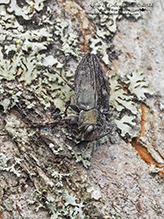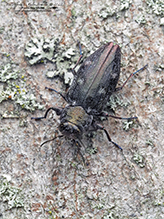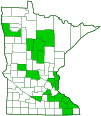flat-headed apple tree borer
(Chrysobothris femorata)
Conservation • Description • Habitat • Ecology • Distribution • Taxonomy
|
|
||||||||||||||
Description |
Chrysobothris is a very large genus of metallic wood-boring beetles. Many of the at least 690 species are very similar in appearance and are difficult to separate by physical features. Chrysobothris femorata is a species complex, a group of closely related species that cannot be reliably separated by appearance and host plants. The complex has taken the common name of one of its members, flat-headed apple tree borer. Over the years, many specimens in museums and university collections that could not be otherwise assigned to a species have been labeled as “C. femorata species complex”. Until recently, there were five species recognized in this group. A recent revision of the group (Wellso and Manley, 2007) resurrected one species that had been demoted to a synonym, and it described six new species, bringing the number of species in the Chrysobothris femorata species complex to twelve. Five of these species have been recorded in Minnesota. Flat-headed apple tree borer is a native, small to medium-sized, metallic wood-boring beetle. It occurs throughout the United States and southern Canada, in Mexico, and in Central America. The larvae feed on the sapwood and heart wood of a wide variety of woody plants. They attack trees that have been cut down, injured, or stressed by age, fire, flooding, or drought. They have a very wide variety of host species. They prefer apple, birch, cherry, hawthorn, maple, pear, poplar, and sycamore, but they have been recorded breeding on 24 genera of deciduous woody plants. They can be a serious pest in commercial orchards with stressed or wounded trees. Adults are active from May to August. They are found in deciduous forests on bark exposed to sunlight and beneath the bark. Adults are 5⁄16″ to ⅝″ (7.0 to 16.0 mm) in length. Females are larger than males. The body is rigid, broad, elongated oblong, and slightly flattened. The upper side is black with metallic bronze or copper reflections and indistinct pale spots. The head is flattened. The face on the male is often bright green. The plate on the face (clypeus) is evenly rounded on the sides, and it is sharply and distinctly notched on the lower margin. The antennae are yellowish green at the base, becoming reddish toward the tip. They have 11 segments. The third segment is slightly longer than the fourth and fifth segments combined. The fourth through eleventh segments are distinctly saw-toothed (serrate). The antennae are inserted in a short, oblique groove. The mouthparts are directed downward. The thorax is more than two times wider than long. The plate on the upper side of the first segment of the thorax (pronotum) is coarsely pitted (punctate) and unmarked. There is a shallow depression in the middle from the rear almost to the front margin. On each side of the depression there is a smooth, thickened, slightly raised area. The plate between the wing bases (scutellum) is large and is angled with concave sides. The wing covers (elytra) are a little wider at the base than the pronotum. They are almost parallel at the base, widest just beyond the middle, and strongly narrowed to the tip. They are distinctly grooved, especially toward the inner margin (suture). The tips are broadly angled and distinctly separated. The surface is densely punctate. Each elytron has three or four dark, longitudinal grooves. The grooves extend from the base to the tip but are often interrupted or indistinct. There are three horizontal depressions on each elytron, a small one near the base, a large one just before the middle, and another large one just beyond the middle. The larger depressions are distinct, paler inside, and crossed by one of the dark grooves. This makes each depression appear as a closely spaced pair of pale spots. The third segment (femur) of the front legs is strongly toothed. The last part of each leg (tarsus), corresponding to the foot, has 5 segments. The first tarsal segment is longer than the next two combined. There is a pair of claws at the tip of each tarsus. The claws are equal in size. On the male, the fourth segment (tibia) on the front legs is curved and has a row of fine teeth on the inner side. |
Size |
Total length: 5⁄16″ to ⅝″ (7.0 to 16.0 mm) |
Similar Species |
Habitat |
Deciduous forests |
Ecology |
Season |
One generation per year: May to August |
Behavior |
|
Life Cycle |
|
Larva Hosts |
At least 24 genera of deciduous woody plants |
Adult Food |
|
Distribution |
||
|
Sources |
|
| 3/1/2024 | ||
Occurrence |
||
Common |
||
Taxonomy |
|
Order |
Coleoptera (Beetles) |
Suborder |
Polyphaga (Water, Rove, Scarab, Long-horned, Leaf, and Snout Beetles) |
Infraorder |
Elateriformia |
Superfamily |
Buprestoidea |
Family |
Buprestidae (jewel beetles) |
Subfamily |
Buprestinae |
Tribe |
Chrysobothrini |
Genus |
Chrysobothris |
Subordinate Taxa |
|
double-spotted jewel beetle (Chrysobothris adelpha) flat-headed apple tree borer (Chrysobothris femorata) four-stamped jewel beetle (Chrysobothris quadriimpressa) green-headed jewel beetle (Chrysobothris viridiceps) jewel beetle (Chrysobothris caddo) jewel beetle (Chrysobothris comanche) jewel beetle (Chrysobothris mescalero) jewel beetle (Chrysobothris pauciflosculosa) jewel beetle (Chrysobothris seminole) jewel beetle (Chrysobothris shawnee) jewel beetle (Chrysobothris wintu) wrinkle-headed jewel beetle (Chrysobothris rugosiceps) |
|
Synonyms |
|
Buprestis femorata Buprestis insculpta Chrysobothris dissimilis Chrysobothris insculpta Chrysobothris nigritula Chrysobothris obscura |
|
Common Names |
|
flat-headed apple tree borer flatheaded appletree borer |
|
Glossary
Clypeus
On insects, a hardened plate on the face above the upper lip (labrum).
Elytra
The hardened or leathery forewings of beetles used to protect the fragile hindwings, which are used for flying. Singular: elytron.
Femur
On insects and arachnids, the third, largest, most robust segment of the leg, coming immediately before the tibia. On humans, the thigh bone.
Pronotum
The exoskeletal plate on the upper side of the first segment of the thorax of an insect.
Punctate
Dotted with pits (punctures), translucent sunken glands, or colored spots of pigment.
Tarsus
On insects, the last two to five subdivisions of the leg, attached to the tibia; the foot. On spiders, the last segment of the leg. Plural: tarsi.
Tibia
The fourth segment of an insect leg, after the femur and before the tarsus (foot). The fifth segment of a spider leg or palp. Plural: tibiae.
Visitor Photos |
||
Share your photo of this insect. |
||
This button not working for you? |
||
Alfredo Colon |
||
 |
||
MinnesotaSeasons.com Photos |
||
|
||
|
||

Slideshows |
|

Visitor Videos |
||
Share your video of this insect. |
||
This button not working for you? |
||
|
Other Videos |
||
METALLIC WOOD-BORING BEETLE sneaky sex. Chrysobothris femorata |
About
Oct 16, 2017 Chrysobothris femorata METALLIC WOOD-BORING BEETLE female searching for a place to oviposit, first moves out of the way of a Hornet, and then a male sneaks up and jumps on her for vigorous mating. Carlyle Lake, IL 9/15/2017 |

Created: 3/1/2024 Last Updated: © MinnesotaSeasons.com. All rights reserved. |



